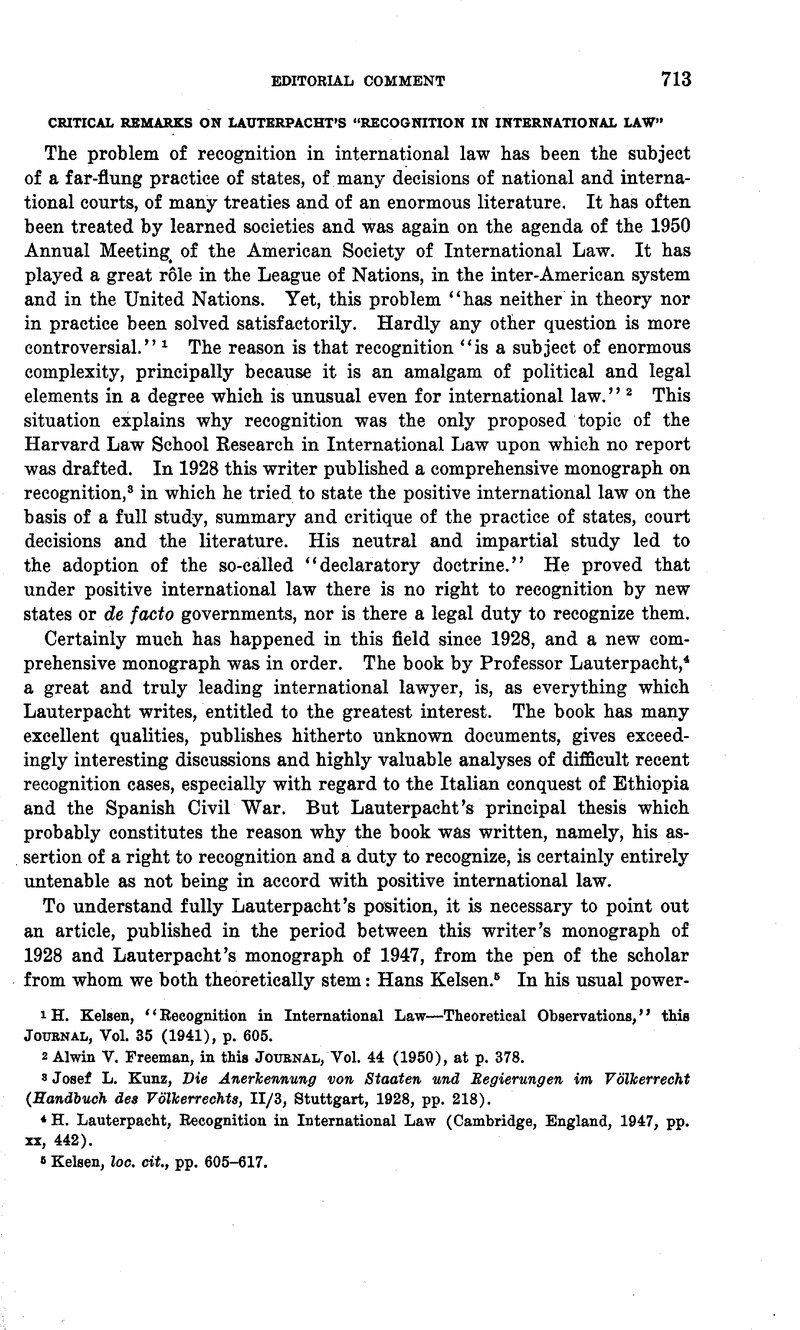Article contents
Critical Remarks on Lauterpacht's “Recognition in International Law”
Published online by Cambridge University Press: 20 April 2017
Abstract

- Type
- Editorial Comment
- Information
- Copyright
- Copyright © American Society of International Law 1950
References
1 H. Kelsen, “Recognition in International Law—Theoretical Observations,” this JOURNAL, Vol. 35 (1941), p. 605.
2 Alwin V. Freeman, in this JOURNAL, Vol. 44 (1950), at p. 378.
3 Josef L. Kunz, Die Anerlcennung von Staaten, und Begierungen im Völherrecht (Handbuch des Völlcerrechts, II/3 , Stuttgart, 1928, pp. 218).
4 H. Lauterpacht, Recognition in International Law (Cambridge, England, 1947, pp. xx, 442).
5 Kelsen, loc. cit., pp. 605-617.
6 See Philip M. Brown, “The Effects of Recognition,” this JOURNAL, Vol. 36 (1942), pp. 106-108; and Edwin Borchard, “Recognition and Non-Recognition,” ibid., pp. 108-111.
7 See H. Kelsen, Das Problem der Souveränität (1921), pp. 224-241, and Allgemeine Staatslehre (1925), pp. 126-127.
8 See, e.g., the book review by E. J. Cohn in Law Quarterly Review, Vol. 64, No. 255 (July, 1948), pp. 404-408, and the critical remarks by Herbert W. Briggs, “Recognition of States, Some Reflections on Doctrine and Practice,” this JOURNAL, Vol. 43 (1949), pp. 113-121.
9 Philip C. Jessup, A Modern Law of Nations (New York, 1948), pp. 43-67, at p. 55.
10 Ibid., p. 46.
11 Lauterpacht, op. cit., p. vi.
12 Ibid., p. 6.
13 Ibid., p. 75.
14 Ibid., p. 147.
15 L. Oppenheim, “The Science of International Law: Its Task and Method,” this JOURNAL, Vol. 2 (1908), pp. 313-356.
16 U.N. General Assembly, International Law Commission, Survey of International Law (Lake Success, N. Y., 1948), pp. 64, 66.
17 Montevideo Convention of 1933 on Eights and Duties of States, Art. 3.
18 Lauterpacht, op. cit., p. 6.
19 Ibid., p. 32.
20 Ibid., p. 171.
21 Thus recently Eolando Quadri speaks of the “paesi anglo-americani che tradizionalmente si considerano investiti di una specie di superportere internazionale,” Diritto Internazionale Pubblico (Palermo, 1949), p. 298.
22 G. Balladore Pallieri, Diritto Internazionale Private (2nd ed., Milan, 1950), p. 95.
23 See e.g., the well-known cases: Wulfsohn v. Eussian Socialist Federated Soviet Eepublic (1923), 234 N. Y. 372: “Its recognition does not create the state” ; Sokoloff v. National City Bank (1924), 239 N. Y. 158; Salimoff & Co. v. Standard Oil Co. of New York (1933), 262 N. Y. 220.
24 116 British and Foreign State Papers, p. 438; this JOURNAL, Vol. 18 (1924), p. 147.
25 Opinions of Commissioners, 1927, p. 42; this JOURNAL, Vol. 21 (1927), p. 160.
26 See, recently, Jimfénez de Aréfichaga, Reconocvmiento de Gobiernos (1947).
27 Jessup, op. cit., p. 44.
28 Hackworth, Digest of International Law, Vol. I (Washington, 1940), p. 173.
29 See Philip M. Brown, “The Beeognition of Israel,” this JOUBNAL, Vol. 42 (1948), pp. 620-627.
30 Hackworth, op. cit., p. 161. He also clearly states: “There is no obligation to recognize that a status of belligerency exists.” Ibid., p. 391.
31 See Alwyn V. Freeman, loc. cit., p. 379.
- 5
- Cited by


